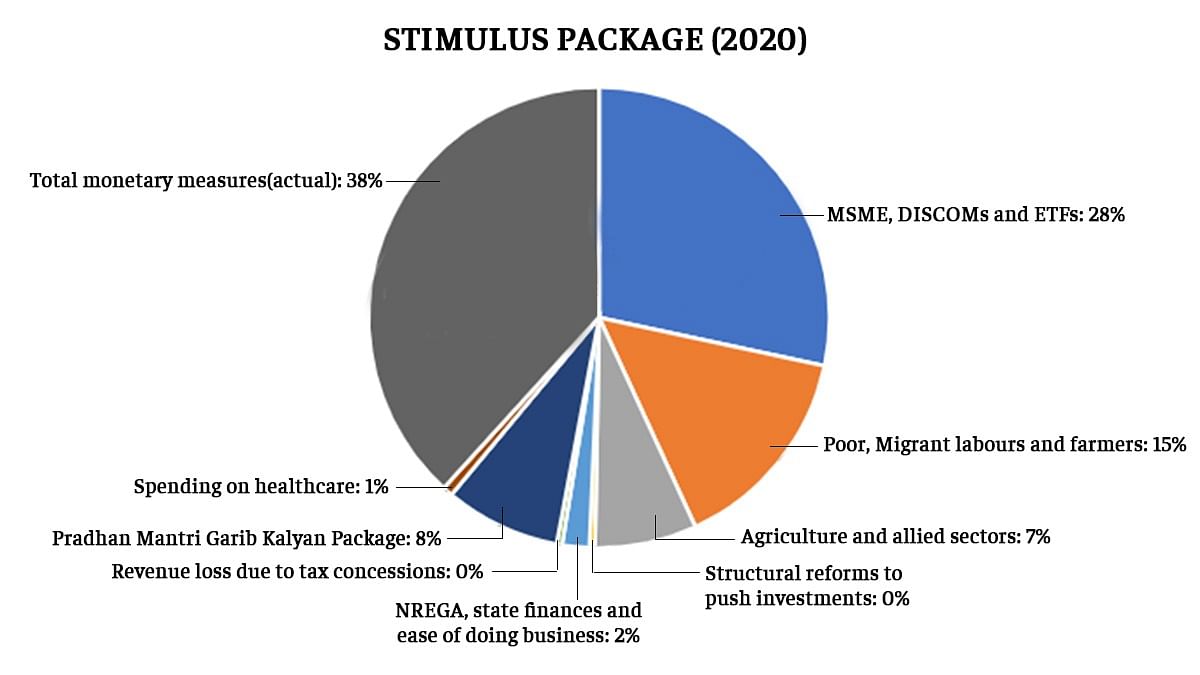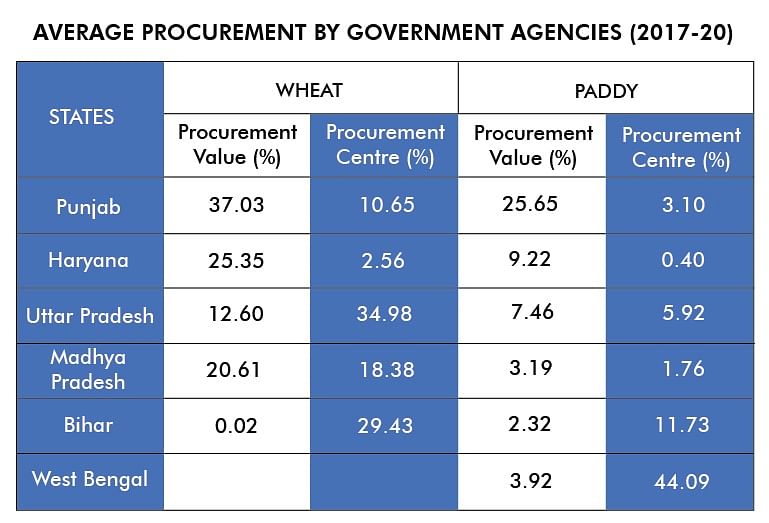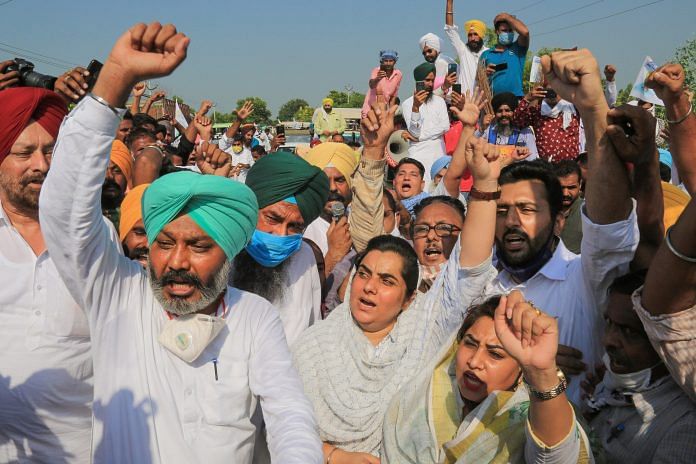The farmers’ agitation against the Narendra Modi government’s agriculture legislation is getting bigger with those protesting also receiving political backing. However, a look at the history of agricultural protests in independent India shows that the benefits of such struggles aren’t always reaped by all sections of the farming community— protests have remained largely ineffective to usher in meaningful policy changes. Even the most popular uprisings of the 1980s led by Bharatiya Kisan Union have not been very effective as they furthered only the interest of large farmers, with no agenda for the small farmers and labourers.
The farmers’ march from Nashik to Mumbai in March 2018 was triggered by large scale destruction of crops and improper implementation of loan waiver schemes. It was organised by All India Kisan Sabha (AIKS), backed by the Communist Party of India (Marxist). The Maharashtra government did promise to fulfil the demands, but they were never executed. In November 2019, All India Kisan Sangharsh Coordination Committee (AIKSCC), a coalition of about 200 farmers’ organisations from across India, organised a movement against the inclusion of agriculture in the Regional Comprehensive Economic Partnership (RCEP) free trade agreement. India ultimately opted out of the RCEP, but more due to the fear of dumping of industrial goods than for its concerns around protecting domestic agricultural producers.
The Charan Singh era
India has a long history of farm movements. Surplus generated out of the Green Revolution made farmers a politically significant group. Chaudhary Charan Singh was one of the first to identify its potential. He formed the Bharatiya Kranti Dal in 1967 and became the leader of Bharatiya Lok Dal in 1974 after merging the former into six other parties that were in opposition to the Indira Gandhi government. He promoted the interest of rich and middle peasants belonging to middle and backward castes. He fought for the abolition of landlordism, consolidation of landholding and resisted taxing agricultural surplus. The farmer leader had also initiated a food procurement scheme in Uttar Pradesh after becoming the chief minister in 1967. This led to significant upward bias in agricultural prices and profitability of agriculture in subsequent decades.
Chaudhary Charan Singh formed the Bharatiya Kisan Union (BKU) in 1978. After his death in 1987, Mahendra Singh Tikait resurrected the organisation in Uttar Pradesh. The BKU took a non-political position, which it continues till now to draw its legitimacy. In the 1980s, the BKU led movements protesting against high power tariffs and erratic supply. The organisation demanded remunerative prices, parity in power rates with other states, and lowering of input costs. The dharna organised by Tikait in Meerut in January 1988 attracted lakhs of peasants, including women. The Uttar Pradesh government relented to the pressure by providing concessions and including the BKU representatives in the Agricultural Prices Commission and local development bodies. Zoya Hasan in her 1989 paper in Economic and Political Weekly says that the benefits given by the government were more rhetorical than real.
The BKU’s movements of the late 1980s, however, had limited success. That’s because it was a movement to protect and promote the interests of surplus producers by maximising only their economic returns, and did not involve the entire farming community. The leadership belonged to the affluent peasant class— teachers, former Army men and retired government officials. The BKU’s demands did not take into account the interests of poor peasants, agricultural labourers and artisans. The organisation had no concern for the minimum wage rate. The poor peasant and agricultural labourers who participated in the movement did so due to their primordial loyalties. As a result, all groups of the farming community did not emerge as a united force.
Also read: Farm reform laws open the market. Now, a regulator is needed
Small share in the Atmanirbhar package
The farming community in India has failed to organise big movements and pressurise the government to fulfil its demands in recent times. The stimulus package, given by the Narendra Modi government to revive the economy from the shocks of Covid-19, has little to offer to the agricultural sector. The package that accounts for 10.05 per cent of India’s GDP, includes fiscal and monetary measures. Only 7 per cent from this economic package has been dedicated to agricultural and allied sectors even when it is most important to invest in this segment of the economy because the migrant labourers who have returned from big cities would ultimately depend on traditional agriculture till the economy revives.
Among all the segments of the Indian economy, large and medium industries are probably the best organised with multiple chambers of commerce and industry associations and representations in each state. Most sectors are well placed to propagate their interests with help from sector-specific associations or federations to serve their interests. In spite of lower attention to agriculture and very minimal support given to the migrant labourers, there has not been any farmer or labour unrest raising these issues. This reveals the lack of capacity on part of the poor farmers to organise as a group and raise their demands.

Also read: Amarinder vows to fight ‘malicious, anti-national’ farm laws through agitation, legal action
A protest of the few
The lack of the farming community’s ability to emerge as a united force across the states and farming class is evident in the ongoing protests against the farm legislation as well.
According to the Shanta Kumar Committee report in 2015, only six per cent of the farmers could sell their produce to government agencies. Hence, the ongoing protests serve the interest of only a tiny portion of the farming community.
The protest is intense in states where the value of procurement is higher, and not necessarily in states that have more procurement centres. While more than 60 per cent of the procurement (in terms of value) of wheat takes place in Punjab and Haryana, only 13 per cent procurement centres are from these two states. Bihar, where the APMC Act was repealed in 2006, still accounts for 30 per cent procurement centres, with a miniscule 0.02 per cent procurement, making these centres economically unimportant for the farmers.
Similarly, 25 per cent procurement of paddy takes place in Punjab, where only 3 per cent procurement centres are operating. Furthermore, 44 per cent procurement centres are in West Bengal, from where a meagre 4 per cent sourcing takes place. This means that the procurement system benefits only a disproportionately lower percentage of farmers — those with very high value of produce. And many of the procurement centres in certain states are economically unimportant for the farmers. It is very natural that the ongoing protests cannot have an all India presence and cannot cover all sections of the farming community.

The inability of the farmers to sell their produce on time and get remunerative prices is a real problem. Although India has modernised in many areas, the interlocking of product, credit, labour and land markets in rural pockets continues to thrive. We need farm movements that demand facilitation of better linkages with markets that practice fair dealings.
The farm movements in India are plagued by overrepresentation of rich farmers as a political force. They provide the critical mass, without which the protests cannot snowball. However, agitations dominated by a few rich farmers may not solve the problem of the farming community as a whole. The interests of all groups have to be advanced. The richer farmers have to set an agenda for the benefit of the poorer and vulnerable members. The participation of the latter would benefit the former, as well as the whole farming community. The community needs to emerge as a unified force to bargain for and usher in meaningful policy and reforms.
Indranil De is Associate Professor, Institute of Rural Management Anand (IRMA), Anand. Sanjib Pohit is Professor, National Council of Applied Economic Research (NCAER), Delhi. Views are personal.




Always the parties in opposition has used farmers as their weapons and now this has become an age-old tradition in India. Country is in crisis and, BJP and Congress still giving blinders to the people from their short-term vision. Undoubtedly India has elected Modi as PM for 2nd term but at the same time we should not forget that India was not having any other option. Modi too has become a puppet of party and Industrialists. Initial days of Modi in 1st term were quite visionary but with time he got moulded as slave of the thorn. In the name of subsidies and security related to farming, all middleman and Industrialists are making money. The hard-working farmer of this country end up serving as labourers during the off seasons. Undoubtedly the farmer of this country are not starving in present but definitely they are getting poorer on daily basis.
New Agriculture reform bill is opening new market and opportunities for the farmers to sell their product across India, and to any party who gives good price,also allow to enter in contract production agreement with parties, which gives surety of price. This is very beneficial to farmers and farmers understands this, that is why they are not protesting, as there is nothing to protest in it.Only middlemen and Brokers which are supported by political parties are protesting, as they are going to loose their business.As farmer will sell product directly to private parties, middelemen will not get their commission, that is why there is protest by middlemen in disguise of farmers protest.
It is nothing related to previous ptotests or organized protests etc which this article claims.Farmers account significant vote bank, No govt will take chance to harm farmers interest. Even if they dont protest and it is not beneficial to them, simply they would not vote and change the Govt.
I am surprised author of this article who is Prof from prestigious management Institute does not understand advantages of this Bill. Instead of focussing on bill he is narrating how to organize protest.which has no relevance.
Why are you so inclined to Modi Govt. How can you say that 2018 farmers protest was led by rich farmers. why they will bother about protests. Only small or middle farmers will raise their voice. Although because of politics their voice was never heard. or politicians never wanted to hear.
Instead of relating it with 1991 industry reform. please go through how these bills or idea had affected USA, Europe, Austrailia Agri sector.
He has done this with data, where is yours ?
Only the middleman and commission artists are complaining about this…..the common farmer have nothing to complain. Khangressi jamaat is using this for political gimmick.